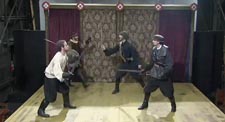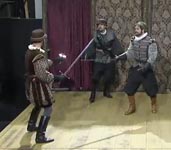- Edition: King Leir
King Leir
- Introduction
- Texts of this edition
- Contextual materials
- Facsimiles
200King Leir, Scene 31
Cast
Mumford: Alon Nashman
Cambria: Scott Clarkson
Cornwall: Jason Gray
Soldier 1: Phil Borg
Captain: David Kynaston
Queen's Men Stage Directions (Sc. 31)
201Read about the Queen's Men stage directions in Scene 30
The end of the previous scene marks the beginning of the battle proper but the dialogue in this scene depicts its final stages. The opening stage direction "Sound alarum, excursions" (TLN 2614) followed by the curious "Mumford must chase Cambria away, then cease" (TLN 2615) are all we have to indicate the final battle in the text. The first is a standard marker for a battle scene with the plural "excursions" suggesting an extended sequence of short fights. The second stage direction indicates a specific event that must happen within the battle in order to motivate the dialogue to come. Aside from this specific instruction, the company was free to invent its own battle sequence.
202 The SQM company worked with a fight director to create a sequence that showcased the fighting skills of Gallia in addition to Mumford's relentless pursuit of the "Welshman" Cambria (TLN 2626). Compared to the surprise attack on the town, the final battle was designed to feature more impressive swordplay. Mumford in particular is shown fighting two soldiers at once. For the final performance, the company had to completely re-block this fight for the new space and the stage fighting consequently feels a little awkward in places in the video. It should still give the viewer a sense of what we were trying to achieve and how much can be made out of such brief stage directions.
Read more about the Queen's Men stage directions.
Performing Mumford (Sc. 31)
203Read about performing Mumford in Scene 30
The scene is designed to place Mumford, rather than Gallia, at the forefront of the battle. This seems an odd choice and the idea that the role might have been played by Tarlton, the master of fence and great clown, helps justify the dramaturgy. The scene is an excellent opportunity for the actor playing Mumford to demonstrate his skill with a sword and with his tongue.
Performing Cornwall and Cambria (Sc. 31)
204Read about performing Cornwall and Cambria in Scene 30
The actors playing the two kings reverted to their initial bumbling characterizations as they fled the field of battle. These characters stands as indexes of the Queen's Men's principle of mixing broad comedy and high drama, they can be stately and commanding at one moment and naïve and bumbling the next.
Watch video of Scene 31 on the Performing the Queen's Men website. (The video footage is password protected. Click on "Cancel" in the pop-up window to obtain password.)



